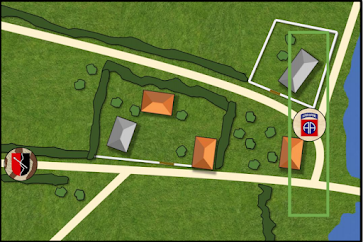"All American: The Battle for La Fière, 1944"
A campaign for Chain of Command by William Thorpe
My friend and Chain of Command opponent Cam had already painted a US Airborne platoon, having been inspired by Band of Brothers. We therefore looked for “Pint Sized Campaigns” which featured US Airborne and found William Thorpe’s “All American: The Battle for La Fière”.
Opposing Forces
Cam is playing elements of the 82nd Airborne Division, one of the best light infantry divisions in the entire US Army. The 82nd “All American” Airborne Division was an exceptionally well-trained unit with combat experience in Sicily and Italy.
As the German player, I will be playing elements of the 1058 Grenadier Regiment (91 Air Landing Division) and Panzer-Ersatz-Abteilung 100.
Panzer Abteilung 100 was a training unit with a motley collection of captured French tanks and at least one Panzer III G, presumably leftover from 1940. The 91st Air Landing Division was formed in January 1944 and subsequently transferred to Normandy. It was deployed to protect the base of the Cotentin peninsula. It was basically a conventional infantry division, despite the “Air Landing” designation. Although Allied intelligence rated the division as “second rate”, most of its troops fought doggedly.
Cam and I will both be commanding company-strength forces of three platoons plus support. Using details provided in the Campaign Book, and also the "At the Sharp End" campaign rule book, we rolled random personalities for our senior leaders.
Campaign Setting and Structure
The campaign book author, William Thorpe, writes:
“After I wrapped up writing my Carentan campaign, I was most interested in researching the exploits of the 82nd Airborne that also dropped into Normandy on D-Day. The German armored assault that was repulsed at La Fière was striking to me in how it was critical to both sides’ military endeavors: for the Germans it was their avenue for tanks to reach Utah Beach, while for the Americans it was their way to breakout and expand the Normandy front.”
This Chain of Command campaign focuses on a causeway across the Mederet River. Many of the areas at the base of the Cotentin peninsula had been flooded by the Germans. Access between the beach and inland areas was over a small number of narrow causeways. These causeways became strategically vital because the Allies needed them to push inland, and the Germans needed them to send reinforcements to Utah Beach.
The small La Fière bridge and its connecting causeway were vital during the early D-Day operations because they were the main link between separated elements of the 82nd Airborne Division. On the western side of the causeway was the medieval church and hamlet of Cauquigny, and on the eastern side was the small stone bridge of La Fière and a manor house of the same name.
The US Airborne, having landed the night before, took the bridge on D-Day and held it until relieved, despite determined German attacks to retake the causeway and bridge.
The campaign has four scenarios. If the Germans win Scenario Four on or before Campaign Turn Seven, they win the campaign. If the Americans stop the Germans, they win the campaign (which is the historical result). In other words, the Germans need to capture both sides of the causeway including pushing the American paratroopers out of La Fière Manor before Campaign Turn Seven.
This pre-war photo shows the area (before the fields either side of the road were flooded by the Germans):
 |
| Source: Murphy, 2009 |
Reading list
There is a good description of the La Fiere battle here
Other good sources are:
Robert M. Murphy, No Better Place to Die (Casemate, 2009).
Steven J Zaloga, Utah Beach & the US Airborne Landings (Osprey, 2012).
US Army Centre for Military History, Utah Beach to Cherbourg: 6 - 27 June 1944 (American Forces in Action Series) (first printed 1948, now available online).
































